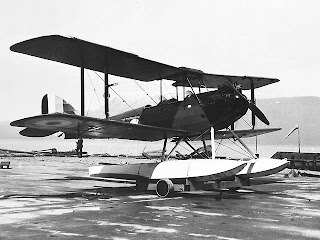This aeroplane was built in 1928 as a de Havilland DH60G Moth seaplane with a Cirrus II engine. It was registered as G-EBYV in the name of Major A A Nathan of the de Havilland Company on 23rd June 1928 and later sold on to Kenneth E Parker and Ian Robertson Parker who were sugar merchants from Liverpool but the aircraft was based at Gosport in Hampshire.
There is a report that it was originally based at RAF Mountbatten, the former Cattewater seaplane station at Plymouth, Devon and was frequently used by T E Lawrence (Lawrence of Arabia) during his time in the Air Force. This information has been confirmed by Major A A Nathan's grandson who has kindly offered me a photograph of T. E. Lawrence beside the aeroplane. Unfortunately I cannot send him my email address because incoming emails are (no reply) anonymous and I do not have his email. Should he read this, my email address is nevillebougourd@gmail.com
On 2nd June 1931 it was sold to Iona National Airways whom, I believe, were Ireland's first commercial airline, and was re-registered in Ireland as EI-AAG. Prior to this sale, it had been converted to a land plane. Whilst in Ireland it was re-engined with a Gypsy engine from another damaged aircraft and was thus converted to a Gypsy Moth.
It was sold to Newcastle upon Tyne Light Aeroplane Club at Cramlington aerodrome and reverted to its original registration of G-EBYV on 16th September 1932.
During its operational life it was twice entered in the King's Cup - a prestigious round Britain air race. The first occasion was on 28th July 1928 when the race statistics were 38 entrants of which 36 started and 23 finished; one plane crashed, killing the pilot. On this occasion the plane was flown by a professional pilot, Wing Commander Sydney William Smith.
The Race started from Hendon aerodrome in London and flew a circuitous route around Britain, reaching as far north as Renfrew in Scotland and returning to Brooklands aerodrome in Surrey. On this occasion Wing Commander Smith was forced to retire at Nottingham after a collision on the ground with an Avro Avian III, G-EBZD, piloted by Flight Lieutenant Boyes.
On 5th July 1930, it was listed as a competitor again, with Ian Robertson Parker, a sugar merchant and later, RAF Officer, from Liverpool as the pilot. The official entry shows it as a de Havilland Moth with a Cirrus II engine. The race started from London Hanworth aerodrome, flying a circuitous course as far north as Cramlington aerodrome and returning by an equally convoluted route around the western side of the country.
Of the 101 entrants, only 88 actually started and 61 finished; the race was won by Miss Winifred Brown in an Avro Avian III at an average speed of 102.75mph. Ian Robertson Parker was not placed but did finish the course.
On 30th June 1936, piloted by Samuel Smith, one of the sons of the founder of the Ringtons Tea company, the aircraft came to an ignominious end and ended up upside down in the yard at Glebe Farm, Medomsley near Consett. The pilot, Samuel Smith was thrown out and hit Mrs Armstrong, the farmer's wife. They were unhurt but both ended up in the slurry pit or the duck pond - sources differ. Some say that the wing tip clipped Mrs Armstrong, knocking her into the slurry pit and that the pilot fell out of the inverted plane and just landed in it.
 |
| Wreck of G-EBYV - inset Samuel Smith, pilot |
Photo courtesy of Newcastle City Libraries
On 6th March 1937 Samuel Smith was involved in another crash in which his aircraft , de Havilland Tiger Moth G-AELA, "The Ringtonian" was written off in a crash near Newcastle Airport. The photograph below was kindly supplied by the Smith family and copyright is theirs.
A few months later, in May 1938, Samuel Smith and two of his friends were killed when the aeroplane he was flying crashed and caught fire at Brundholme Ghyll between Skiddaw and Latrigg in the Lake District in appalling weather conditions. The aircraft was a Percival P10 Vega Gull, registration G-AFGU. The accident was seen and heard 2 miles away in Keswick. Unfortunately no photograph of this plane is available.
The crash reports indicate that he made a violent turn to avoid a mountain and the rudder failed, losing some mechanical parts. The accident was reported in the national press:
The crash reports indicate that he made a violent turn to avoid a mountain and the rudder failed, losing some mechanical parts. The accident was reported in the national press:



